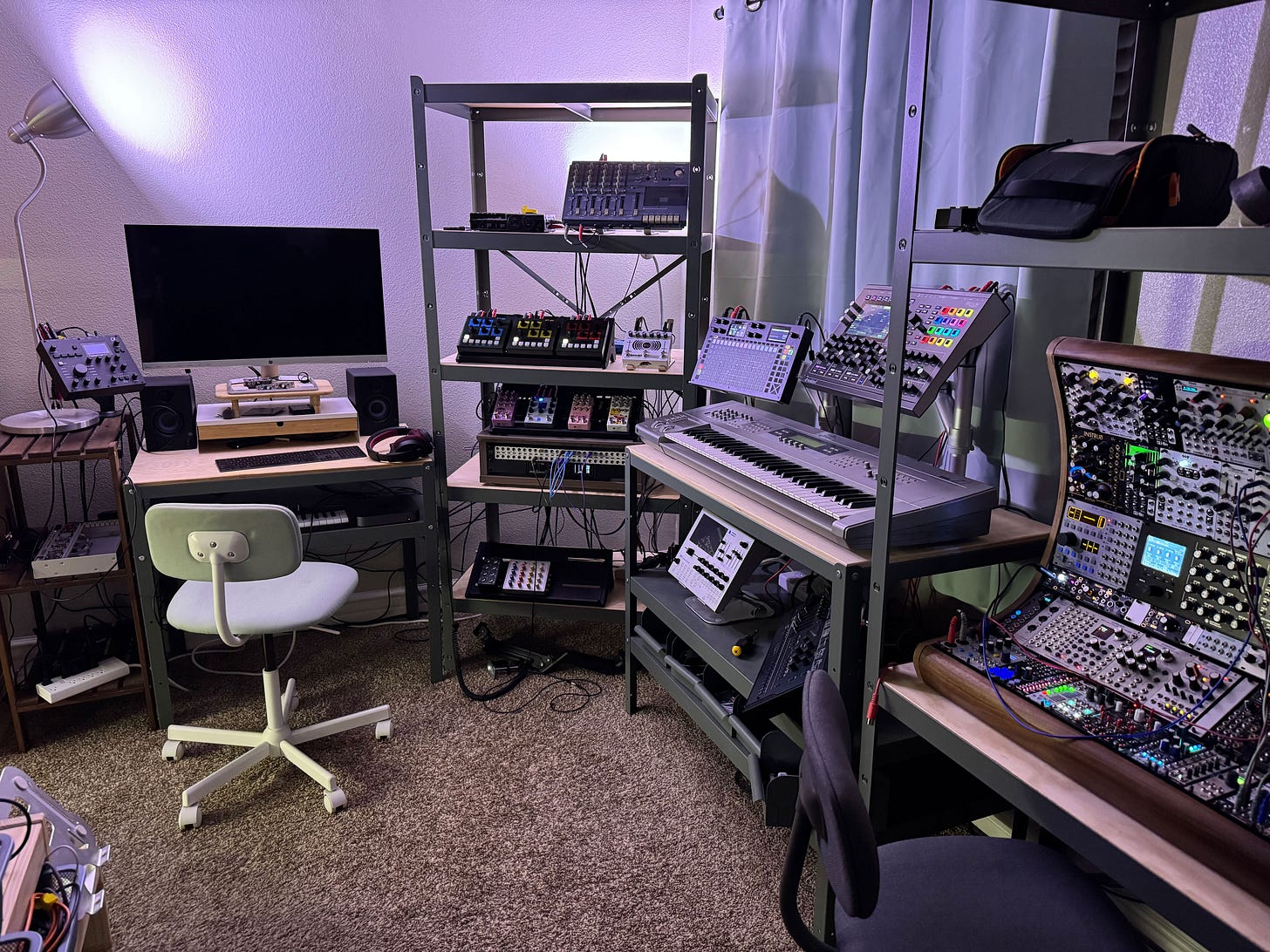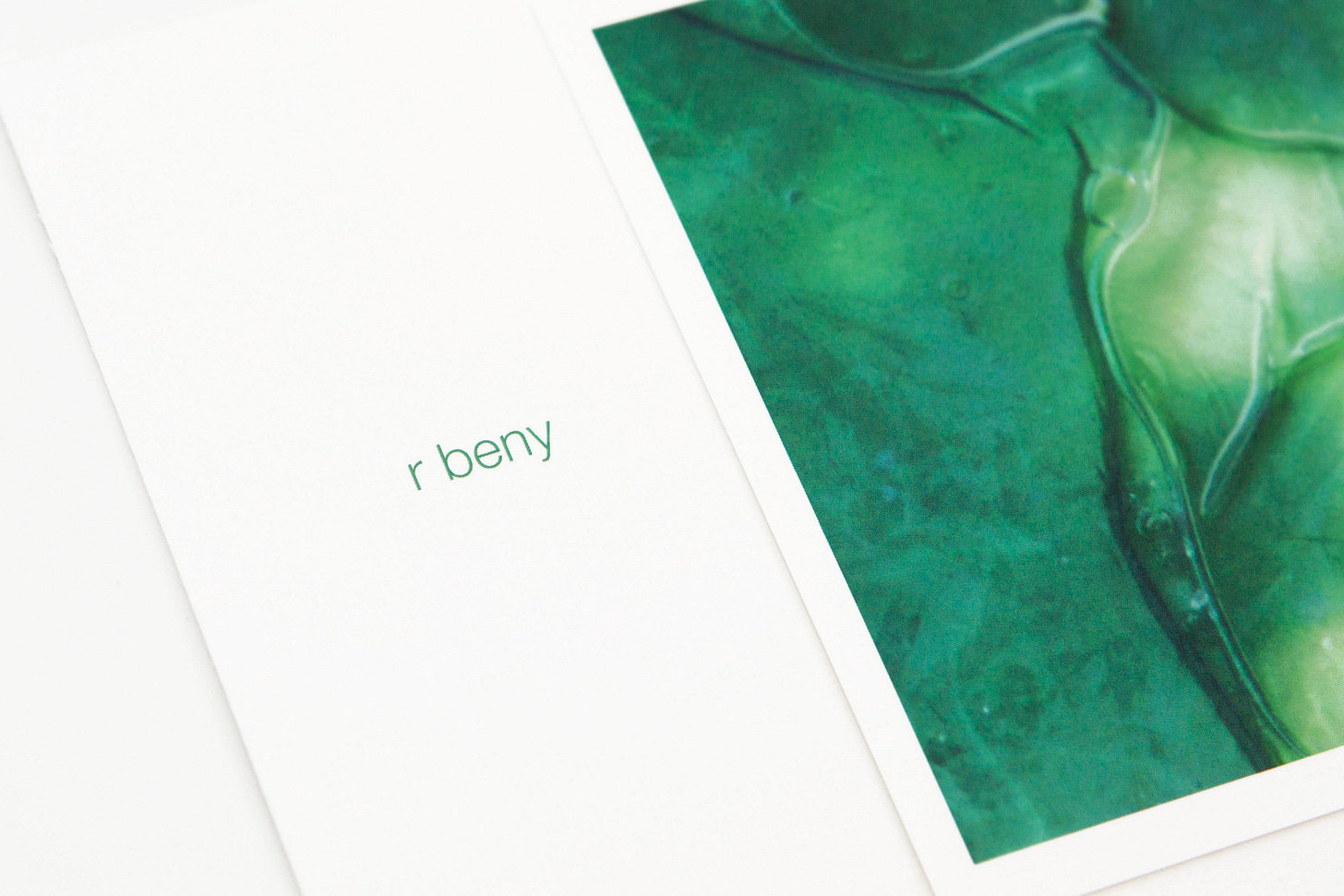Hi friends - hope all good :)
Today really pleased to share the second part of my Q&A with r beny. Austin’s been known for a long time as a highly proficient synthesist and technician - one of those rare artists that uses these skills in a deeply musical way, never letting technology overtake the core message and using it adroitly to fully express himself.
Also the last day of half-price digital today and some CDs left if you want.
Part Two
Please can you give us an overview of your studio and favourite instruments?
My studio currently resides in my apartment dining room. At the heart of it all is my main sequencer, the Squarp Hapax, and a patchbay. Whichever instruments, effects, or equipment I happen to have out all get connected to the Hapax and the patchbay. This allows me to make music swiftly, with minimal setup time. The patchbay is connected to multiple ins and outs of a MOTU UltraLite mk5, which interfaces with my DAW of choice, Reaper. Everything is connected to everything, anything can interact with anything. I tend to prefer to work on headphones rather than monitors.
The aforementioned Hapax is my favorite sequencer and is fundamental to the music I make. Instead of programming sequences, I tend to use it as a MIDI or CV looper, capturing myself playing a keyboard or another MIDI/CV controller. It does a great job at capturing the nuances of a human performance - while I still set a tempo and use a metronome, I like my music to be slightly off time.
Currently, one of my favorite synthesizers is the Korg Z1. 80% of the sound sources on this album are the Z1, whether heavily processed or not. I love the uncanny valley acoustic sounds that physical modeling synths produce and the Z1 is just an absolute gem in that regard. For myself, physical modeling is not about replicating the sound of true-to-life acoustic instruments, but rather creating patches that have acoustic characteristics. As a synth from the 90s, it’s not the quickest or most pleasant synth to program, but it just has a certain charm I’m drawn to. The keyboard also feels wonderful to play.
My favorite Z1 model is the reed model, which tries to emulate saxophones, clarinets, oboes, flutes, double reeds, bassoons, harmonicas and more. It has this airy, noisy quality to it that I just love and seemed to fit in well with the theme of the album.
Some of my other current favorites that ended up on the album include the Tasty Chips GR-1, the Waldorf Iridium, the OTO suite of effects, the Chase Bliss Lossy, and eurorack. Some of my current favorites eurorack modules include Frap Tools Fumana, 4ms Ensemble Oscillator, Mutable Instruments Beads, and Rossum Assimil8or.
Please can you gives a quick breakdown of how you made each track?
Braid into chorus
The bulk of the track features 9 layers of different Z1 sequences (using patches I made with the Z1’s reed models) being processed by Chase Bliss Lossy and OTO Bim. I imagined the various reed/woodwind instruments weaving in and out and playing off of each other, as if they were individual streams in a river. The main sound is dense, but each individual part is delicate and sparse.
The second half of the track gives way to Z1 plucks and processed field recordings from a rainy day at Wunderlich County Park, along with a couple more layers of Z1 reeds. Some of the Z1 pluck layers were processed by Beads and Chase Bliss Mood. There are several layers of processed field recordings. Some of them were captured in Blukac Endless Processor and then further processed by Synthesis Technology E520 Hyperion using the Spectral Crusher program, as well as Rossum Morpheus. Everything runs through the OTO Boum.
Fragile nowhere
This track originally started out as an outro to “Meander mapping”, which was planned as a much longer track. The outro originally started with a Mood-sampled bit of the end of “Meander mapping” proper running through Bim, creating this hypnotic, almost-rhythmic wave of sound. A pair of Z1 reeds running through a Marantz PMD-430 cassette recorder on a tape loop in tape-monitor mode were also a part of the original outro. I loved the duet of these Z1 sounds so much, I knew I had to flesh them out into a track of their own. Two Z1 flutes and three Z1 oboes (each running through Bim) round out the bulk of the track. The last section of the track gives way to Beads-processed Z1 plucks and a field recording of waves crashing on the rocks from Salt Point State Park. Everything runs through the OTO Boum.
Meander mapping
This track started out with a phrase from the Iridium, using its resonator engine. The resonator engine allows for samples to be used to excite the resonator - here I’m using a recording I took at a stream at the Ptarmigan Lake Trail in Colorado. The resonator section is joined by 4 layers of GR-1 playing samples of the Z1, all running through Bim. The bass is a clarinet from Z1. The track is rounded out by a pair Mood-sampled GR-1/Z1 layers. Everything runs through the OTO Boum.
Fir-sweet and mossed
“Fir-sweet” started out by vocoding a Z1 line with a field recording I took of the San Lorenzo River in Felton, CA using the Frap Tools Fumana. By using music as the carrier and a field recording as the modulator, the Z1 takes on the dynamics and characteristics of the field recording, almost as if they become one. I ran one instance of the vocoded track through Bim. I ran another through the Chase Bliss Reverse Mode C using its octave up pitch shifter, which creates the crystal-like sounds. Another instance ran through OTO Bam, which is one of the few instances of reverb on the album. Finally, there’s a time-stretched version of the vocoded track, created using the Spectral Time Machine program on the E520.
From there, the track gives way to 8 layers of Z1 saxophones and flutes, all running through various effects chains featuring Bim, Lossy, Reverse Mode C, and Mood.
Nearing the completion of the album, I accidentally played a track that didn’t make the album at the same time as “Fir-sweet” and realized that they fit together nearly perfectly. I ended up adding some of these parts (Mandolin being spectrally processed by the E520 spectral program) to the last part of the track, which gave it an extra bit of sparkle. Everything runs through the OTO Boum.
Echoing pastoral
The oldest material to make the album, this was originally part of a much longer piece that I worked out during live performances. It starts with mandolin and a layer of Beads-processed mandolin, before moving onto several layers of Z1 flutes sampled by the 1010 Lemondrop and the GR-1. The bass is from the Iridium resonator. The track also features a field recording from a stream in Felton. Everything runs through the OTO Boum.
Mantled spring
Probably the simplest track on the album. There’s 4 layers of GR-1 sampling Z1 running through Bim, with a Z1 bass before ending with a layer of Mood-processed Z1, and a layer of Beads-processed Z1. Everything runs through the OTO Boum.
Many thanks to Austin for going into such depth, so often the artists that are the most confident and comfortable with their process are the most willing to share - wonderful to read all this from him.
Couple of shout-outs today - support the writers and DJs friends, so much appreciation for what they do.
Thanks to Andrew Khedoori for the mention of discerned in the fugue of streams in the always excellent First Impressions - highly recommend subscribing.
Also to awesome supporters No Place Like Drone for playing a qd25 track - essential regular listening on Dublin Digital Radio, archived here.
Thanks again for everything friends, have a great weekend x
Alex
quietdetails.com
quiet details Bandcamp
quiet details Substack
quiet details studios - mastering and audio services







